To improve your sleep in just a week, start by identifying your main disruptor, like screen time or caffeine. Choose one habit to change—such as turning off screens 30 minutes before bed—and stick to it consistently. Create a calming bedtime routine, like gentle stretching or listening to soothing music, and keep your sleep environment dark and cool. If you keep these tips in mind, you’ll see noticeable progress—and there’s more you can do to sleep better.
Key Takeaways
- I identified that screen time before bed was disrupting my melatonin production, so I stopped using devices 30 minutes prior to sleep.
- Establishing a consistent bedtime helped regulate my internal clock and improved sleep quality within just one week.
- Using a calming routine, like reading and listening to soothing music, signaled my body to wind down effectively.
- Creating a dark, quiet, and comfortable sleep environment reduced disturbances and promoted more restful sleep.
- Tracking my sleep patterns allowed me to notice improvements and adjust habits for sustained better sleep.
Identifying the Culprit Disrupting My Sleep
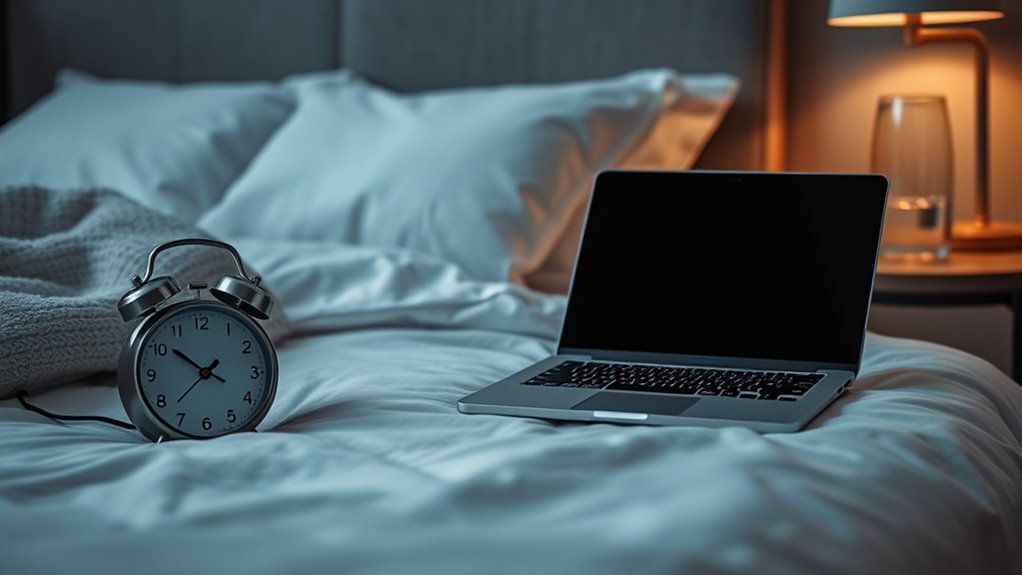
Have you ever wondered what might be quietly sabotaging your sleep? Often, small habits like caffeine consumption and screen time habits play a bigger role than you realize. Drinking coffee or energy drinks late in the day can make it harder to fall asleep because caffeine blocks sleep-inducing chemicals. Meanwhile, excessive screen time before bed exposes you to blue light, which suppresses melatonin production. This hormone is vital for signaling your body to prepare for sleep. Recognizing these habits helps you pinpoint the culprits behind restless nights. By understanding how caffeine and screens impact your sleep cycle, you gain control over your environment and routines. Additionally, awareness of data privacy challenges can help you protect your personal information as you make these lifestyle changes. Identifying these habits is the first step toward making meaningful changes that promote healthier sleep.
Choosing the Right Habit to Change
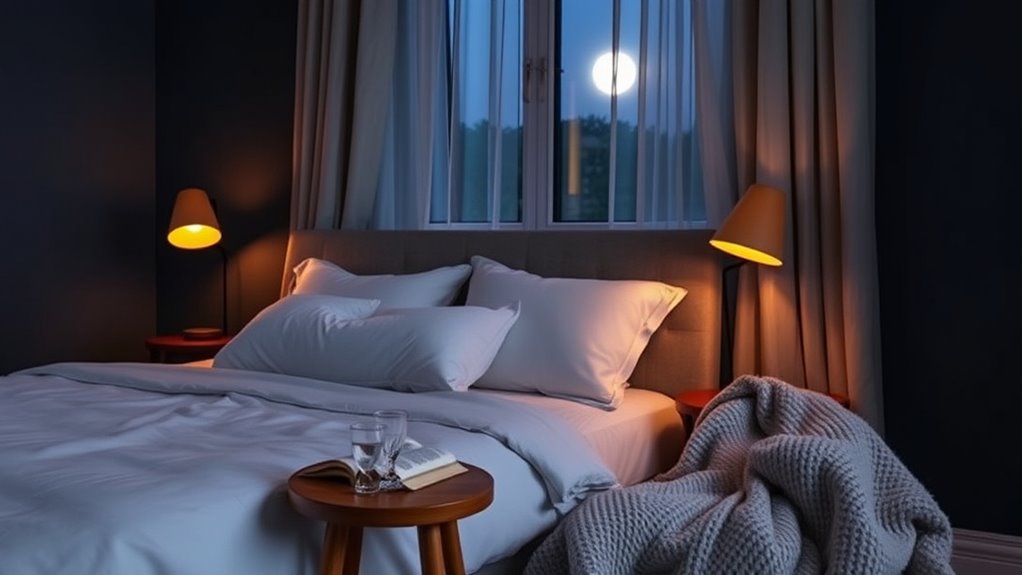
Once you’ve identified the habits disrupting your sleep, the next step is choosing which one to tackle first. This is where habit selection and behavioral focus come into play. Pick the habit that has the biggest impact on your sleep quality or is easiest to change. Focusing on one habit helps prevent overwhelm and increases your chances of success. Consider which change will be most sustainable and address the root cause of your sleep issues. Don’t try to overhaul multiple behaviors at once; instead, prioritize the one that offers the clearest benefit. By narrowing your behavioral focus, you create a clear path forward, making it easier to stay committed and see real progress in just one week. Additionally, understanding factors such as contrast ratio can help optimize your environment for better sleep quality.
Establishing a Consistent Bedtime Routine
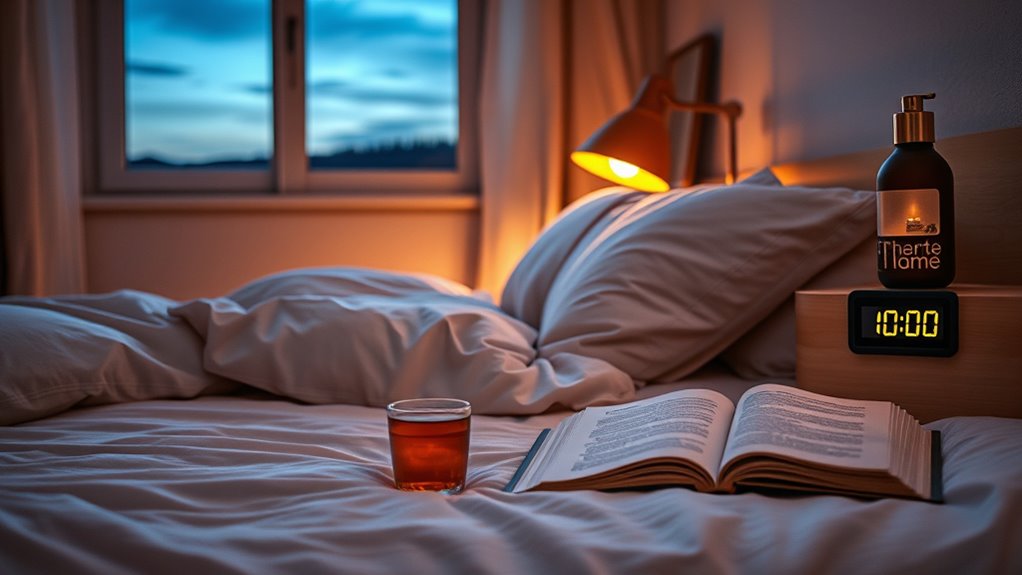
After choosing the habit that will make the biggest difference, the next step is to establish a consistent bedtime routine. Good sleep hygiene relies on predictable evening routines that signal your body it’s time to wind down. Start by setting a fixed time to go to bed each night, even on weekends. Incorporate calming activities like reading, gentle stretching, or listening to soothing music. Avoid screens at least 30 minutes before bed, as blue light disrupts melatonin production. Consistency helps regulate your internal clock, making it easier to fall asleep and wake up refreshed. Establishing a calming pre-sleep routine further reinforces your body’s signals for rest. By establishing these evening routines, you create a stable environment for restful sleep, helping your body shift smoothly from wakefulness to sleep each night.
Creating a Restful Sleep Environment
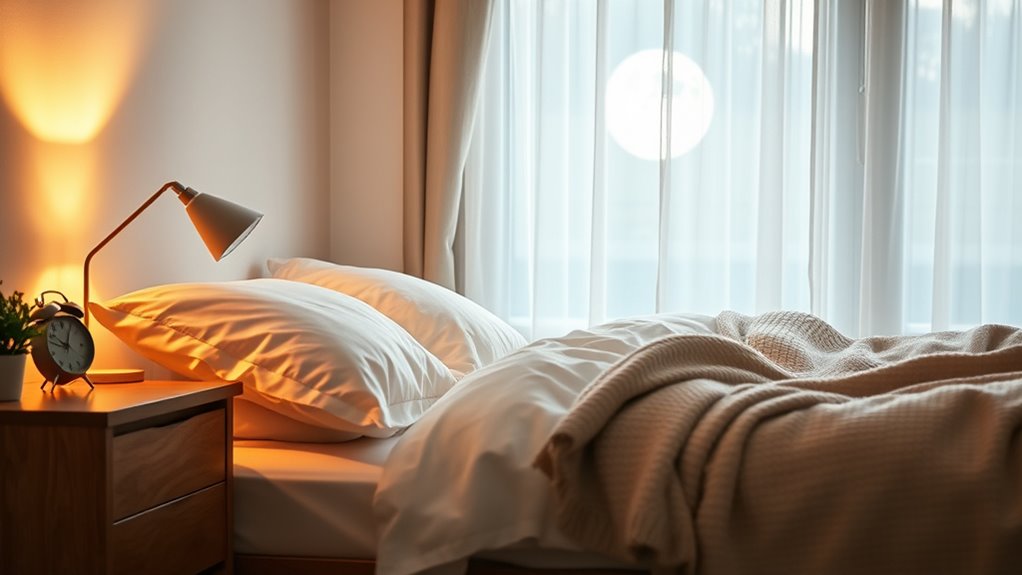
Creating a restful sleep environment is essential for quality rest, as your surroundings can considerably influence your ability to fall asleep and stay asleep. To improve your environment, focus on noise reduction—use earplugs or a white noise machine to block disruptive sounds. Lighting control is equally important; keep your room dark by using blackout curtains or a sleep mask, signaling to your body that it’s time to rest. Avoid bright screens at least an hour before bed, as blue light can interfere with melatonin production. Maintain a cool, comfortable temperature and keep your space tidy to promote relaxation. Additionally, using essential oils like lavender or chamomile through a diffuser can help create a calming atmosphere that encourages sleep. These small adjustments can make a significant difference in creating an ideal sleep setting, helping you drift off faster and enjoy deeper, more restorative sleep.
Tracking My Progress and Adjusting as Needed
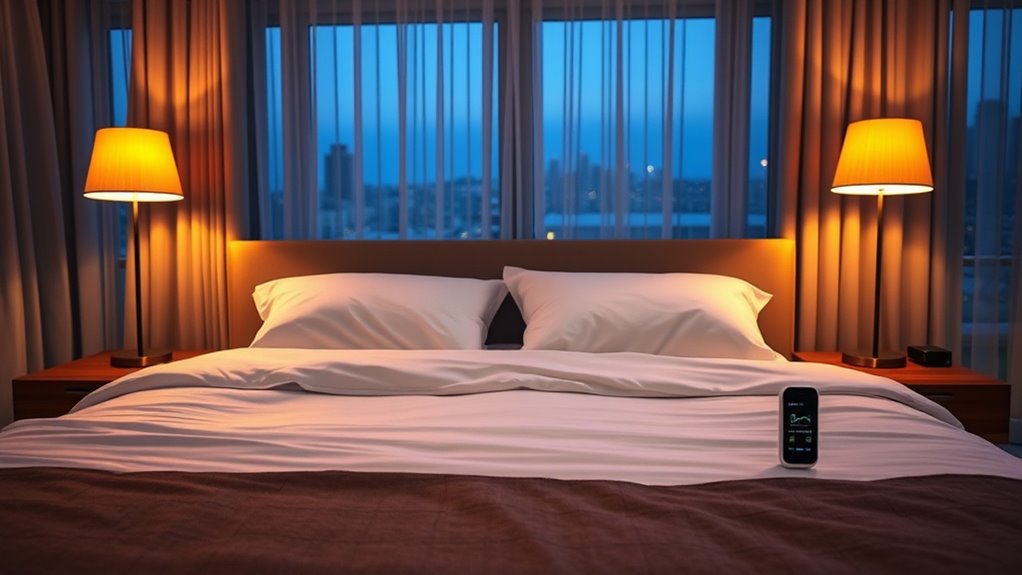
You start by monitoring your sleep patterns to identify trends and disruptions. Then, you analyze your sleep data to see what’s working and what needs improvement. Based on this, you make data-driven changes to optimize your sleep routine.
Monitoring Sleep Patterns
Tracking your sleep patterns provides valuable insights into what’s working and what isn’t. By monitoring your sleep, you can identify habits that improve your sleep hygiene and detect signs of sleep disorders early. Use a sleep journal or an app to note bedtime, wake time, and how rested you feel. Pay attention to factors like nighttime awakenings or difficulty falling asleep, which can indicate underlying issues. Regular tracking helps you see trends and adjust your routines accordingly. If you notice consistent problems, it might be time to consult a professional. Incorporating sleep-friendly habits into your routine can further enhance your sleep quality. Monitoring your sleep isn’t just about numbers; it’s about understanding how your habits affect your rest. This awareness empowers you to make informed changes and optimize your sleep quality over time.
Analyzing Sleep Data
Analyzing your sleep data turns your observations into actionable insights. By reviewing your sleep patterns, you can identify trends like how long you spend in each sleep cycle or when dreams occur. Dream analysis helps reveal if stressful dreams or vivid dreams disrupt your rest, signaling possible stress or anxiety. Tracking your sleep cycle shows whether you’re getting enough deep and REM sleep, which are vital for feeling refreshed. If you notice frequent awakenings or irregular sleep stages, you can adjust your habits accordingly. This step allows you to understand what’s working and what’s not. Paying close attention to your sleep stages enables you to make informed decisions that optimize your sleep quality and overall well-being.
Making Data-Driven Changes
Once you’ve gathered sufficient sleep data, the next step is to make targeted adjustments based on your insights. If your sleep logs show inconsistent sleep hygiene, focus on establishing a consistent bedtime and reducing screen time before sleep. Consider incorporating melatonin supplements if you struggle with falling asleep, but consult a healthcare professional first. Track how these changes impact your sleep quality and duration. If you notice improvement, reinforce these habits; if not, tweak your routine further. Adjustments might include dimming lights earlier or avoiding caffeine later in the day. Regularly reviewing your data helps you identify patterns and make informed decisions, ensuring each change moves you closer to better sleep. Making data-driven tweaks empowers you to optimize your sleep routine effectively. Incorporating air quality improvements, such as using an air purifier with HEPA filtration, can also contribute to better sleep by reducing allergens and airborne pollutants.
The Results: How My Sleep Improved Over a Week
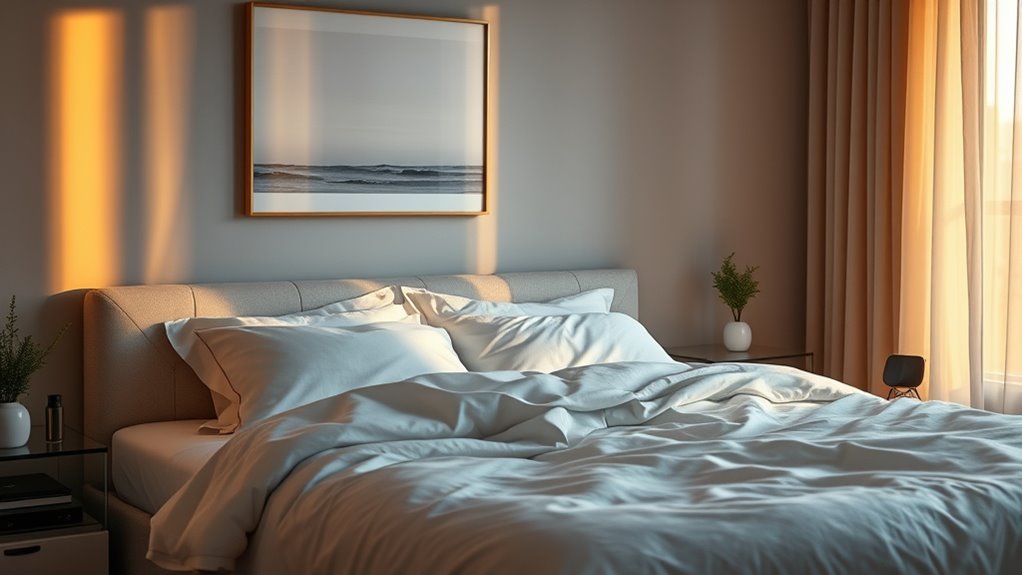
After just one week of implementing new sleep habits, you’ll notice a significant difference in how rested you feel each morning. Improving your sleep hygiene, like sticking to a consistent bedtime and reducing screen time before bed, has already made a noticeable impact. You might find yourself falling asleep faster and waking up feeling more refreshed. Additionally, paying attention to dream analysis helps you understand your sleep quality better; vivid or frequent dreams can indicate deep sleep cycles. Over the week, you’ll likely experience more restorative sleep, less tossing and turning, and an overall boost in your energy levels. These small but intentional changes create a clearer, more restful sleep pattern that continues to improve with each passing day.
Frequently Asked Questions
Can Changing One Habit Have Long-Term Effects on Sleep Quality?
Changing one habit can definitely have long-term effects on your sleep quality. When you focus on improving sleep consistency and establishing effective bedtime routines, you create a stable environment for your body to relax and rest better. Over time, these small changes strengthen your sleep patterns, making it easier to fall asleep and wake up refreshed. Consistent habits and routines help sustain improved sleep quality long-term.
What Are Common Mistakes to Avoid When Trying to Improve Sleep?
Did you know 35% of adults struggle with poor sleep? When trying to improve sleep, avoid common mistakes like inconsistent bedtime routines and excessive caffeine intake. Skipping a regular sleep schedule confuses your body’s internal clock, making falling asleep harder. Also, consuming caffeine late in the day disrupts rest. Focus on establishing a calming bedtime routine and limiting caffeine to make sure of better quality sleep every night.
How Quickly Can I Expect to See Results From Habit Changes?
You can start noticing improvements in your sleep within a few days to a week by tracking your habits and refining your sleep routines. Habit tracking helps you identify patterns and make necessary adjustments quickly. Consistency is key; sticking to your new routines boosts results. While some may see rapid benefits, others might take longer, so stay patient and keep monitoring your progress to optimize your sleep quality effectively.
Are There Any Risks Associated With Modifying Sleep Habits?
Ever wonder if changing your sleep habits might be risky? While focusing on sleep safety is essential, most habit risks are minimal if you make gradual adjustments. Sudden shifts could disrupt your sleep cycle or cause fatigue. To stay safe, consult a healthcare professional if you have underlying conditions. Remember, mindful changes promote better sleep without compromising your health, ensuring your journey to improved rest remains safe and effective.
How Do Sleep Improvements Impact Overall Health and Daily Performance?
Improving your sleep offers numerous benefits for your health and performance. Sleep benefits include better immune function, mood, and cognitive clarity. When you get quality sleep, your daily performance enhances—you’ll feel more energized, focused, and productive. Prioritizing good sleep directly boosts your overall health, reducing risks of chronic illnesses and improving your mental well-being. By making simple changes, you release these positive effects, helping you thrive both physically and mentally.
Conclusion
By changing just one habit, you can transform your sleep faster than you’d find a gold ring in a haystack. Stick with your new routine, keep your environment cozy, and track your progress—before you know it, you’ll be snoozing like it’s the Roaring Twenties. Remember, even a modest tweak can make a world of difference. So, give it a shot—your best night’s sleep is just a habit away!









